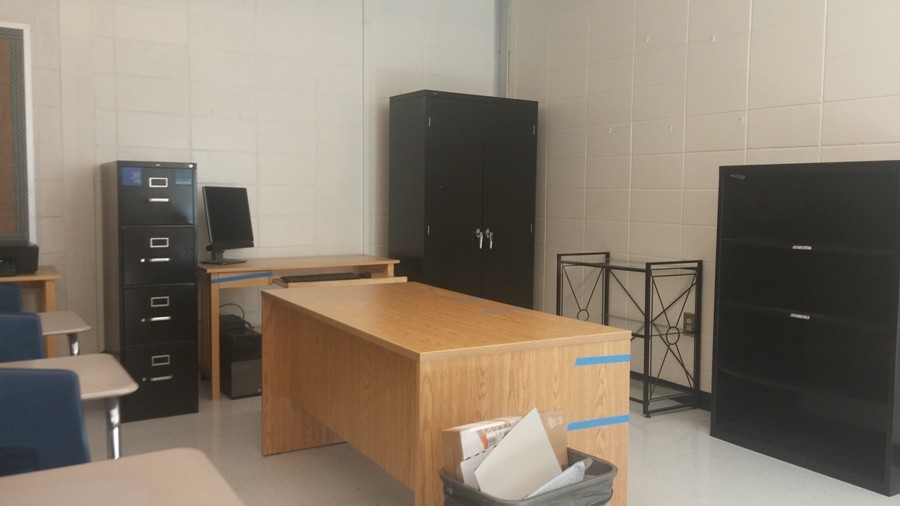Pests find home in SMHS ceiling
Special education teachers Mary Lehman and Jodi Morrow cleaned out their room in preparation for Fayette County Board of Education maintenance workers to replace their ceiling tiles this afternoon. There have been reports of rats in the ceiling of the room, and every time the ceiling tiles are moved to put in traps, rat droppings fall.
February 12, 2016
The Director’s Cup, state athletics championships, award-winning musicals and high-rankings among the nation’s top schools documents that Starr’s Mill really does “demand excellence.”
Trophies spill out of cases, and plaques hang on almost every wall. Yet above these cases and behind these walls, something nibbles and scratches at the foundation of the school, threatening the health of teachers and students.

Fayette County Board of Education maintenance workers replaced some ceiling tiles from room 727. Special education teachers Jodi Morrow and Mary Lehman had to vacate the room, and the workers placed the infected tiles in the hallway next to English teacher Lela Crowder’s room on Feb. 10.
Rats, first becoming a problem in the spring of last year, have left their mark inside the ceiling of the school. This year, room 727, shared by special education teachers Mary Lehman and Jodi Morrow, got a whiff of the problem first-hand.
“They moved the ceiling tiles to put rat traps up there,” Morrow said, “and every time they move them, rat poop falls.”
Fayette County Board of Education maintenance workers came on Wednesday to replace some of the ceiling tiles, but Lehman and Morrow had no warning before they began their work. Both teachers vacated the room while the county worked on the ceiling, and the old tiles were stacked outside Lela Crowder’s room next door.
Principal Allen Leonard said they “had a report of an odor from those ceiling tiles,” which is why they took measures to change the tiles.
Rat droppings were found Thursday Feb. 11 under Lehman’s desk in the left corner of the room, and she plans to move her work space to an office in the media center.
The rest of the ceiling tiles are being replaced today at 4 p.m. because of the “increased rodent activity,” according to Mike Satterfield, director of facilities at FCBOE. The county crew will move the furniture, cover the room in plastic, and requests the school custodians to thoroughly clean the room after the tile changes.
English teacher Jillian Bowen is also scheduled to have her ceiling tiles removed because of an incident last year regarding rats nesting in her ceiling.
Last time the ceiling tiles were moved in room 727, rat droppings fell onto Lehman’s desk, contaminating her papers and room. “When the rat poop got on the floor they swept it,” Morrow said, “and I didn’t know this at first, but when there’s rat poop, there’s a process for getting rid of it, and it’s not sweeping. You have to spray it and let it sit and wipe it up.”

Special education teacher Mary Lehman had rat droppings under her desk after Fayette County Board of Education maintenance workers replaced some of her ceiling tiles on Wednesday.
Leonard said he worked with a county to keep the students’ safety in mind when replacing the rest of the infected tiles. “We’re going to do it in a time where we have nobody in that classroom and on a Friday where any dust or anything that might have come out of that ceiling-tile change would have settled before students came back into that classroom,” Leonard said.
According to the Center for Disease Control, the cleanup process after a rat infestation must begin with disinfecting the urine and droppings and waiting a couple minutes before wiping the area. Through sweeping, vacuuming or dusting the droppings, particles can mix into the air and infect people with diseases carried by rodents.
Rats and mice can spread over 35 diseases through contact with the rodents or their feces, urine and saliva. Indirectly, more disease can be spread through ticks or fleas on these animals.
“Ms. Lehman and I both have had headaches,” Morrow said. She attributes this to the smell of urine in her room because of the rats. “They put peppermint up there, so for a while we could smell pee and peppermint,” she said.

After Fayette County Board of Education maintenance workers moved ceiling tiles to put rat traps in room 727, rat droppings contaminated the room. Special education teacher Jodi Morrow said they swept these droppings into the hall, which the Center for Disease Control advises against.
Neither teacher seem to have any other health problems relating to the infestation.
The teachers requested an air purifier after the incident, but FCBOE would not provide the funds to pay for it. “[The air purifier] came out of special education funds,” Morrow said. “I think the funds actually come from the state. I’m not sure they should be spent on something like that, but it’s for the students’ safety.”
Satterfield said he doesn’t think there are any health concerns regarding the rats and doesn’t know of any infestation this year. “I haven’t heard any reports of them being back this year,” he said. “I know last year we battled them for several months.”
Though the problem has been scaled back through the county and school’s preventative measures, the school “continue to catch vermin,” Leonard said. The rats are “on campus, but not where students are walking and students are having class.”
Rats have been reported in the courtyards and in the ceilings.
Satterfield thinks the rats began nesting in Starr’s Mill because of the construction of the Gates subdivision across Highway 74. “I believe their habitat got destroyed and they started looking for other places to live,” he said, “and you got a school, which is a pretty good source of food, when you start looking at all the food in the school and in the dumpster.”
Leonard said all schools are susceptible to rats because of the open doors and food. “We can certainly do a lot to fight any infestation of vermin by prohibiting all drink and all food in all the classrooms,” Leonard said, “but that also probably would make school very difficult for a lot of our students. It would be a huge culture change.”
Satterfield also said the bird feeders in the courtyard as well as a compost pile created by a science class contributed to the problem. “Once we discovered those, we asked the school to get rid of them,” he said, “and I think that helped a good bit.”
The county then went around the building and sealed all the possible places rats could enter into the school. “They found a couple of nests where pests might come in from the outside and work their way in,” Leonard said.
Rats can climb, so they sealed holes from the base of the school to the roofline. “Any type of hole that would give them access to the building you’re looking for to get sealed up,” Satterfield said.
Professional exterminators came during the summer to curb the problem, but heavy chemicals cannot be used to eliminate the rats. “Part of the challenge we face is that we’re very limited in the methods that we can use to keep pests out,” Leonard said, “because we would not like to kill the children when we kill the pests, so we have to be very careful.”
As for the rats already inside the school, the custodial staff set mechanical and glue traps inside the ceilings. Media specialist and Ex Libris sponsor LeighAnne Hanie seals Ex Libris book club food in popcorn tins after hearing rats.
“We had one rat that I know of in the magazine room that got into some leftover food that has since been thrown away,” Hanie said. “The janitor put a rat trap out that evening and caught it that evening, and I haven’t seen anything since.”
Despite sealing holes and trapping pests, rats continue to be a problem at the Mill.
“I feel like everyone here has done a wonderful job,” Morrow said. “Tri, the custodians and [assistant principal David] McBride. It’s the people above who I don’t think are allowing them to do whatever they need to do to make the problem go away.”
This summer, the South Complex is due for a new roof and roofing units, and this renovation may give them more leeway to rid the school of rats without students and faculty in the building.
Starr’s Mill hits the 20-year mark during the summer of 2017, and the school will have a complete renovation of the inside as well, including painting the walls and replacing ceiling tiles.
Despite reports of rats, the county doesn’t plan on beginning the major clean-up process ahead of schedule and will proceed with the state-funded renovations.
“This work that we’re doing this summer and next summer was already scheduled,” Satterfield said. “It has nothing to do with the rat problem.”








